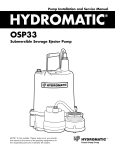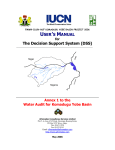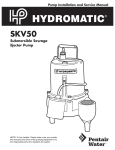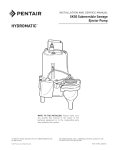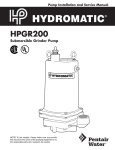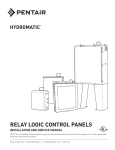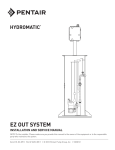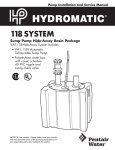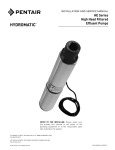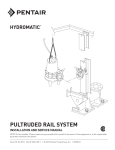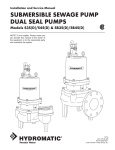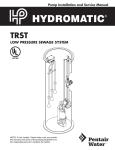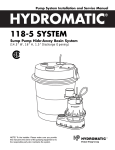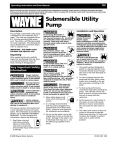Download Pump Installation
Transcript
Pump Installation and Service Manual HYDROMATIC ® S4S Submersible Sewage Pump NOTE! To the installer: Please make sure you provide this manual to the owner of the pumping equipment or to the responsible party who maintains the system. General Information Thank you for purchasing your HYDROMATIC Pump. To help insure years of trouble free operation, please read the following manual carefully. Before Operation: Read the following instructions carefully. Reasonable care and safe methods should be practiced. Check local codes and requirements before installation. Attention: This manual contains important information for the safe use of this product. Read this manual completely before using this product and refer to it often for continued safe product use. DO NOT THROW AWAY OR LOSE THIS MANUAL. Keep it in a safe place so that you may refer to it often. Unpacking Pump: Remove pump from carton. When unpacking unit, check for concealed damage. Claims for damage must be made at the receiving end through the delivery carrier. Damage cannot be processed from the factory. WARNING: Before handling these pumps and controls, always disconnect the power first. Do not smoke or use sparkable electrical devices or flames in a septic (gaseous) or possible septic sump. 2 Pumps Not Operating or In Storage: Pumps with carbon ceramic seals must have impellers manually rotated (6 revolutions) after setting non-operational for 3 months or longer and prior to electrical start-up. Pump: The S3S submersible pumps are supplied for 1 and 3 phase and for 200, 230, 460 or 575 volts. Pump is supplied with 15 feet of power cord. Longer cable lengths can be furnished but must be specified at time of order. Power cable is 4 wire with the green wire for ground. Be sure green wire is connected a ground lug in the control panel and the control panel must be connected to a ground rod or ground wire from supply service. NOTE: All single phase pumps require properly sized start capacitor, start relay and run capacitor in the panel. Sump Level Control: Sump level is controlled by HYDROMATIC 3900 mercury switch level controls. The 3900 level controls is a metal case mercury switch sealed in a solid polyurethane float. The float is held in position by a weight attached to the power cord above the float. The cord supports the float and is adjusted for height from the surface. Typical duplex systems use three Floats; the lowest float turns the pumps off, the next higher float starts the lead pump, the next higher float (override) starts the lag pump. The pumps alternate on successive cycles. Two pumps operate together only if sump level rises to the third or override float. The override float also brings on the second pump in case of failure of the first pump. Extra floats with appropriate controls can be supplied for alarm functions. Triplex systems use four floats. The fourth highest float brings on the second lag pump. Three pumps operate together only if sump level rises to the fourth float (second override). This float also brings on the third pump in case of failure of either or both of the first two pumps. Alarm Controls: The alarm float is usually set above the override level so the alarm will signal only if the override level is exceeded. However, some engineers prefer to have the alarm float set below the override level as it is possible for one pump to fail and the other pump to operate on the override level with the sump level never reaching the alarm level. This is particularly true in cases of low inflow capacity. Electrical Control Panel: It is recommended that the HYDROMATIC control panel be used with all pumps as proper start components and pump protection are furnished. NOTE: All single phase pumps require properly sized start capacitor, start relay, and run capacitor in the control panel. IMPORTANT: If HYDROMATIC control panel is not used and the motor fails because of improper components, the motor guarantee is void. HYDROMATIC electrical equipment is installed in a weatherproof enclosure. The electrical equipment includes a main circuit breaker for each pump, a magnetic starter with overload protection for each pump, a H-O-A switch and run light for each pump, an electric alternator and a transformer to provide appropriate control for control circuit and alarms. Overload Heaters: If a HYDROMATIC control panel is not used, on three phase pumps all three phases must have over load protection. The overload should be ambient compensated class 10. The heaters full load amps on the pump be sized in accordance with the nameplate amps on the motor housing. The amp draw on these submersible motors is slightly higher than a corresponding horsepower surface motor so heaters must be sized by the nameplate full load amp rating. Single phase pumps with capacitor start Circuit must have the overload protection on the black pump lead. NOTE: On single phase pumps the white, black, and red pump leads must be connected properly for the pump to run. Pump Installation Installing: Before installing pump in sump, lay it on side and turn impeller with fingers. Impeller may be slightly stuck due to factory test water so it must be broken loose with small bar or screw driver in edge of vanes. The impeller should turn freely. Clean all trash and sticks from sump and connect pump to piping. A check valve must be installed on each pump. A gate or plug valve in each pump discharge line is also recommended. This valve should be installed on the discharge side of the check valve so if necessary to service the check valve, the line pressure can be cut off. Single pump systems are sometimes installed without a check valve where it is desirable to self-drain the discharge line to prevent freezing. This can be done only with short discharge lines. Otherwise water will return to the sump and cause short cycling of the pump. Nema 4 Junction Box (Optional): If electrical control panel is to be set remote from the pump sump, a NEMA 4 junction box should be used to make power and control connections. The HYDROMATIC NEMA 4 junction box is provided with compression connectors for sealing all wires. No sealing compound is needed to make connections waterproof. Wiring diagrams are provided with panel for making connections. An extra set of diagrams are included so that one set can be used during installation when making connections. The size of any additional wiring from the pump cord to the panel is based on the distance and pump 1 2 3 ;;;; ;;;;; ; ; ; ;; ;;;; ; ; ; ; ; ; ; ;; ; ;; ; ; ; ;; ;; ; ; 4 28 5 24 27 6 (Not Shown) 26 7 8 ; 23 22 9 10 25 19 ;; 11 21 20 18 17 12 13 14 29 15 16 3 the snubber and readjusting cord length. In either simplex or duplex system the lower or turn-off float is set just above the top of volute so that the volute will always be submerged during the pumping cycle. The second or lead/on float higher is set at about 24 inches above the lower turn-off control. More distance between turn-on and turn-off controls can be used but sewage may become septic and excessive solids may collect for the pump to handle. A frequent pumping cycle is recommended for best operation. If an alarm system is used, this control is usually set about 6 inches above the override control. Some engineers as described previously prefer to have the Pump Installation current. Double check that all wiring is properly connected and tight. NOTE: On single phase pumps the white, black and red pump wires must be connected properly to the panel. Only the proper sequence will work. Installing 3900 Mercury Switch Float: The float cords are supported by a mounting bracket that is attached to sump wall or cover or to the NEMA 4 junction box. Cord snubbers are used to hold the cord in place. Float level can be changed at any time by loosening alarm control set below the override control. Making Electrical Connections: All electrical wiring must be in accordance with local code, and only competent electricians should make the installations. A set of prints is included for use in making the installation. All wires should be checked for grounds with an ohmmeter or Megger after the connections are made. This is important, as one grounded wire can cause considerable trouble. IMPORTANT: If equipment is not properly wired and protected as recommended, the motor guarantee is void. WIRE SIZE TABLE FOR REMOTE LOCATION OF CONTROL PANEL LENGTHS ARE BASED ON A VOLTAGE DROP OF TWO PERCENT Maximum length in feet from NEMA 4 junction box to control panel. For 3 phase only and for power lines only. All control wires can be = 14–16 or 18 gauge wire. If power lines are for 460 or 575 volts insulation of control wires must be for this voltage if used in conduit with power lines. Volts Wire Size Motor HP 230 460 575 230 460 575 230 460 575 230 460 575 230 460 575 230 460 575 230 460 575 230 3 3 3 5 5 700 5 71⁄2 71⁄2 71⁄2 10 10 10 50 220 340 15 15 15 20 20 20 25 25 25 30 30 12 110 450 90 370 580 10 180 720 1120 140 550 370 8 270 1100 1650 220 900 1400 175 700 1100 105 420 650 320 500 230 360 180 280 6 400 1600 2500 350 1400 2200 220 900 1400 150 600 930 105 420 650 90 370 570 360 560 320 500 370 1500 2300 230 950 1450 175 700 1100 140 550 850 125 500 800 100 400 620 4 90 360 560 2 35 460 575 35 35 230 360 90 360 560 370 1500 230 270 1100 1700 220 900 1400 210 820 1250 200 800 1250 150 600 930 *Special Junction Box required for wire sizes larger than #4. NUMBER OF CONDUCTORS REQUIRED BETWEEN CONTROL PANEL AND NEMA 4 JUNCTION BOX System Type 4 30 460 575 230 Number of Control Wires Number of Power Lines Number of Ground Wires #8 Simplex 3 3 1 Simplex with Alarm 5 3 1 Duplex 5 6 1 Duplex With Alarm 7 6 1 Pump Operations Starting System: 1. Turn H-O-A switch to off-position then turn on main circuit breakers. 2. Open all discharge valves and allow water to rise in sump pump. 3. Turn H-O-A switch to Hand position on one pump and notice operation. If pump is noisy and vibrates, rotation is wrong. To change rotation (3 phase), interchange any two line leads to motor. DO NOT INTERCHANGE MAIN INCOMING LINES. If duplex system, check second pump in same manner. 4. Now set both H-O-A switches to Auto position and allow water to rise in sump until one pump starts. Allow pump to operate until level drops to turn-off point. 5. Allow sump level to rise to start other pump. Notice run lights on panel; pumps should alternate on each successive cycle of operation. 6. Turn both H-O-A switches to off position and allow sump to fill to the override control level. 7. Turn both switches to Auto position and both pumps should start and operate together until level drops to turn-off point. 8. Repeat this operation cycle several times before leaving job. 9. Check voltage when pumps are operating and check the amp draw of each pump. On 3 phase pumps, check amps on each wire as sometimes a high leg will exist. One leg can be somewhat higher (5 to 10%) without causing trouble. For excessive voltage draw on one leg, the Power Company should be consulted. Pump Maintenance As the motors are oil filled, no lubrication or other maintenance is required. The pump should be lifted once every two years and the oil drained from the motor chamber to check for water. Generally these pumps give very reliable service and can be expected to operate for years on normal sewage pumping without failure. Lightning: In some areas where considerable lightning occurs, it is recommended that a lightning arrestor be installed at the control panel. Complete data on lightning arrestors and cost is available from the factory. Lightning arrestors are good insurance against damage to an expensive motor. Servicing Instructions: IMPORTANT: Read all instructions before replacing any parts. WARNING: Before handling these pumps and controls, always disconnect the power first. Do not smoke or use sparkable electrical devices or flames in a septic (gaseous) or possible septic sump. Field Service On Motor: All submersible motors can be serviced (out of warranty) in the field by any reliable motor service shop. Any pump (in warranty) must be returned to the factory for service or repaired in an authorized HYDROMATIC service center. Charges will not be allowed if (in warranty) pump is not taken to a motor repair shop that is not an authorized HYDROMATIC service center. When field service is performed on a pump, these instructions should be carefully followed. Replacing Stator: If motor winding is burned or shorted, it can be rewound or replaced with new factory wound stator. Refer to sectional drawing of pump and motor and use following steps to remove and replace stator. 1. If stator only is damaged, it may not be necessary to completely dismantle pump as stator and housing can be lifted from pump without disturbing seals or bearings. 2. Drain all oil from upper housing. If oil is clean and no water is present, seals can be considered satisfactory to reuse. 3. After chamber is drained, remove hold down bolts and lift off. Use care in lifting. 4. Set assembly on bench and remove cord cap assembly. When this is lifted off, connection wires to motor will be exposed. These wires will probably be burned but each wire is tagged with a metal marker giving wire number. Cut the wires. 5. If the leads to the cord cap assembly are burned, the assembly must be replaced. 5 Pump Maintenance 6. After stator retaining ring is removed, turn housing upright and bump on hardwood blocks. This should jar the stator loose and allow it to drop out. 7. Thoroughly clean housing before replacing new stator. Replace stator and make all wire connections to cord cap assembly before replacing housing on pump. This is important as leads must be tucked behind the windings by using hands up through rotor core. IMPORTANT: Use only compression type insulated connectors on the wires. Do not tape leads as oil will deteriorate the tape and cause damage to stator and bearings. 8. Check top bearing. If clean and does not turn rough, bearings can be reused and it is not necessary to completely dismantle pump to change bearings. If bearings are damaged with dirt or heat, they must be replaced. See additional instructions on replacing seals and bearings. Remember to reinstall the upper bearing load spring. 9. Replace stator housing onto seal chamber and bolt in place. Be sure O-ring seal has been replaced. If O-ring is nicked or cut, replace the new rings. This applies to all O-rings used in assembly. 10.After all leads are reconnected, make a high voltage ground test on each 6 wire. The only wire that should show ground is the green power lead. 11.Refill motor chamber with oil. Use only high grade transformer oil or regular HYDROMATIC special submersible oil. Fill chamber until oil covers top of windings. Leave air space in top for expansion. Use permatex on plug threads. Replacing Seals And Bearings 1. Drain all oil from motor chamber as described. 2. Remove bolts that hold motor housing to pump housing. Remove screws holding seal plate to motor housing. 3. Lift rotating assembly (rotor, shaft and impeller) from pump case and place horizontally on bench. With hardwood block, tap end of impeller to loosen from shaft. 4. Shaft sleeves are not used. 5. Remove lower seal spring and pry out seal with screwdriver. 6. Use bearing puller to remove bearings. Replace with new bearings. Press only on inner race of bearing when replacing. Pressing on outer race can damage the bearing. Bearings are standard size that can be obtained from any bearing supply house or can be obtained from HYDROMATIC factory. 7. IMPORTANT: Do not use any of the old seal parts. Replace with all new seals. 8. Thoroughly clean all castings before replacing seals. One grain of dirt between the seal faces can cause failure. Examine all O-rings for nicks before reusing. 9. Use Locktite on socket head locking screw in end of shaft. 10.Before refilling chamber with oil, air test as described above. 11.Refill chamber with oil as described above. 12.Always check all leads with high voltage or with megger for grounds before operating the pump. Fig. 1 CONNECTION DIAGRAM FOR LEADS IN MOTOR AND CONNECTION BOX (Y) WYE MOTOR CONNECTIONS 230 VOLTS 460 VOLTS 6 5 4 6 5 4 9 8 7 9 8 7 3 L1 2 1 L3 GREEN 3 2 1 L2 L1 L2 L3 GREEN Pump Troubleshooting Below is a list of common problems and the probable causes: Pump will not start 1. No power to the motor. Check for blown fuse or tripped circuit. 2. Hand-off-auto switch may be in the off position. 3. Control circuit transformer fuse may be blown. 4. Overload relay on starter may be tripped. Push to reset. Pump will not start and overload heaters trip 1. Turn off power and check motor leads with megger or ohmmeter for possible ground. 2. Check resistance of motor windings. All 3 phases should show close to the same reading. 3. If no grounds exist and the motor windings check O.K., remove pump from sump 0and check for clogged or blocked impeller. Pump runs but will not shut off 1. Pump may be air locked. Turn pump off and let set for several minutes then restart. 2. Lower float control may be hung-up in the closed position. Check in sump to be sure control is free. 3. Selector switch may be in the Hand position. Pump does not deliver proper capacity 1. Discharge gate valve may be partially closed or partially clogged. 2. Check valve may be partially clogged. Raise level up and down to clear. 3. Pump may be running in wrong direction. Low speed pumps can operate in reverse 1 2 3 ;;;; ;;;;; ; ; ; ;;; ;; ;; ; ; ; ; ;; ; ; ; ;; ;; ; ; 4 28 5 24 27 6 (Not Shown) 26 7 8 Pump operates with selector switch in hand position but will not operate in auto position 1. This indicates trouble in the float level control or the alternator relay. 2. To check for defective float control put selector switch in auto position and turn off main power. Put a jumper wire on terminal strip. Turn on power and if pump starts, trouble is in float control. Replace control. direction without much noise or vibration. 4. Discharge head may be too high. Check total head with gauge when pump is operating. Total head is discharge gauge pressure converted to feet plus vertical height from water level in sump to center line of pressure gauge installed in discharge line. Gauge should be installed on pump side of all valves. Multiply gauge pressure in pounds by 2.31 to get head in feet. 5. If pump has been in service for some time and capacity falls off, remove pump and check for wear or clogged impeller. ; 25 23 19 22 21 9 20 10 18 11 17 12 13 14 29 15 16 7 S4S Parts List ORDERING REPLACEMENT PARTS: Product improvements are made from time to time. The latest part design will be furnished as long as it is interchangeable with the old part.When ordering replacement parts, always furnish the following information: (1) pump serial number, (2) pump model and size, (3) part description, (4) part number, (5) impeller diameter (if ordering impeller), (6) quantity required, and (7) shipping instructions. Ref. No. Part No. 1 00589-002-1 2 Part Description Qty. Ref. No. Part No. Part Description Eyebolt 2 18 00150-021-1 O-Ring 00178-004-1 Capscrew 2 19 00517-007-1 3 13425-023-1 Nameplate 1 20 4 04580-001-1 Drive Screw 4 5 00087-004-1 Pipe Plug 6 01032-003-1 Nut-Hex- 3/8-16 SST 7 00064-003-1 Load Spring 8 00065-021-1 9 10 Qty. Part No. Part Description Qty. 1 14713-003-1 Stator (71⁄2HP 3ø 230/460V) R 1 Capscrew 4 14713-203-1 Stator (71⁄2HP 3ø 200V) R 1 00995-008-1 Lockwasher 4 14713-603-1 Stator (71⁄2HP 3ø 575V) R 1 21 00299-002-1 Stator Retaining Ring 1 02577-000-1 Wire Connector As Recq. 1 22 05454-001-1 Roll Pin 1 00282-001-1 Wire Connector (14 & 16 wire size) As Recq. 2 23 13391-000-2 Motor Housing 1 01006-001-1 Wire Connector (10 & 12 wire size) As Recq. R 1 24 00834-015-1 O-Ring 06461-023-5 Cord Cap Assy. 15' Single 10/4 1 Upper Bearing R 1 25 10922-024-5 Rotor w/Shaft (3HP 1ø) 1 06461-024-5 Cord Cap Assy. 30' Single 10/4 1 00065-018-1 Lower Bearing R 1 01329-025-5 Rotor w/Shaft (All 3ø) 1 06461-002-5 Cord Cap Assy. 15' Single 12/4 1 04916-000-1 Shaft Seal S 1 12750-023-5 Rotor w/Shaft (5HP 1ø) 1 06461-014-5 Cord Cap Assy. 30' Single 12/4 1 04916-001-1 Shaft Seal (Carbide) Opt C 1 14698-003-1 Stator (3HP 1ø 230V) R 1 10418-000-5 Cord Cap Assy. 15' Single 8/4 1 11 00239-016-1 Capscrew 4 14699-003-1 Stator (3HP 3ø 230/460V) R 1 10418-002-5 Cord Cap Assy. 30' Single 8/4 1 12 01130-003-1 Machine Screw (Flat Head) 4 14699-203-1 Stator (3HP 3ø 200V) R 1 09978-007-2 Impeller (3HP) 1 13 09995-000-2 Volute Case 1 14699-603-1 Stator (3HP 3ø 575V) R 1 09978-008-2 Impeller (5HP) 1 14 10108-000-1 Impeller Washer 1 14711-003-1 Stator (5HP 1ø 230V) R 1 09978-009-2 Impeller (71⁄2HP) 1 15 00238-001-1 Impeller Capscrew 1 14712-003-1 Stator (5HP 3ø 230/460V) R 1 51700-061-7 Seal Kit 16 08908-002-1 Key 1 14712-203-1 Stator (5HP 3ø 200V) R 1 51700-361-7 Carbide Seal Kit 17 09996-002-2 Seal Plate 1 14712-603-1 Stator (5HP 3ø 575V) R 1 * 26 SC Ref. No. SC 1 27 28 29 R Rebuild Kit Notes: S — Parts in Seal Kit C — Parts in Carbide Seal Kit I — Parts in Impeller Kit R — Parts in Rebuild Kit *Consult Factory 8 S4S 1 2 3 ;;;; ;;; ;;; ; ; ;;;;;;; ;; ;;; ;; ; ; ; ; ;;; ; ; ; ; ; ;;;;; ;; ;;;; ;;; ;; ;;; ; ;; ;; ; ; 4 28 5 24 27 6 (Not Shown) 26 7 8 ;; ;; ;; ;; 25 23 19 22 21 9 10 11 12 ;; ; ;; ;; ; 20 18 17 13 14 29 15 16 9 WARRANTY Hydromatic Pumps, Inc. warrants to the original purchaser of each Hydromatic product(s) that any part thereof which proves to be defective in material or workmanship within one year from date of installation or 18 months from manufacture date, whichever comes first, will be replaced at no charge with a new or remanufactured part, F.O.B. factory. Purchaser shall assume all responsibility and expense from removal, reinstallation and freight. Any item(s) designated as manufactured by others shall be covered only by the express warranty of the manufacturer thereof. This warranty does not apply to damage resulting from accident, alteration, design, misuse or abuse. The pump must be installed, operated and maintained in accordance with the published instructions of the appropriate Installation & Service Manual. All dual seal non-clogs and 3–5 HP grinders must have seal failure and heat sensors attached and functional for Warranty to be in effect. If a seal failure should occur, Hydromatic Pumps will cover only the lower seal and labor thereof. Labor based on Authorized Service Center contract allowance. If the heat sensor is not attached and functional, Warranty is void. If the seal failure sensor is not attached and functional, Warranty is void. If the material furnished to the Buyer shall fail to conform to this contract or to any of the terms of this written warranty, Hydromatic Pumps, Inc. shall replace such nonconforming material at the original point of delivery and shall furnish instruction for its disposition. Any transportation charges involved in such disposition shall be for the Buyer’s account. The Buyer’s exclusive and sole remedy on account or in respect of the furnishing of material that does not conform to this contract or to this written warranty, shall be to secure replacement thereof as aforesaid. Hydromatic Pumps, Inc. shall not in any event be liable for the cost of any labor expended on any such material or for any incidental or consequential damages to anyone by reason of the fact that such material does not conform to this contract or to this written warranty. ALL IMPLIED WARRANTIES, INCLUDING THE IMPLIED WARRANTY OF MERCHANTABILITY AND THE IMPLIED WARRANTY OF FITNESS FOR A PARTICULAR PURPOSE, ARE DISCLAIMED TO THE SAME EXTENT AS THE EXPRESS WARRANTY CONTAINED HEREIN. Some states do not allow limitations on how long an implied warranty lasts, so the above limitation may not apply to you. MANUFACTURER EXPRESSLY DISCLAIMS AND EXCLUDES ANY LIABILITY FOR CONSEQUENTIAL OR INCIDENTAL DAMAGES FOR BREACH OF ANY EXPRESS OR IMPLIED WARRANTY ARISING IN CONNECTION WITH THIS PRODUCT, INCLUDING WITHOUT LIMITATION, WHETHER IN TORT, NEGLIGENCE, STRICT LIABILITY CONTRACT OR OTHERWISE. Some States do not allow the exclusion or limitation of incidental or consequential damages, so the above limitation or exclusion may not apply to you. This warranty gives you specific legal rights, and you may also have other rights which vary from State to State. © 1999 Hydromatic®, Ashland, Ohio. All Rights Reserved. – Your Authorized Local Distributor – 1840 Baney Road Ashland, Ohio 44805 Tel: 419-289-3042 Fax: 419-281-4087 www.hydromatic.com ISO 9001 Certified Part# 5625-321-1 Item# E-03-321 5M 1/01










